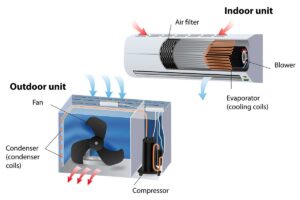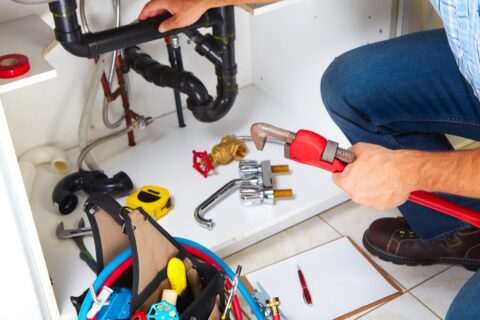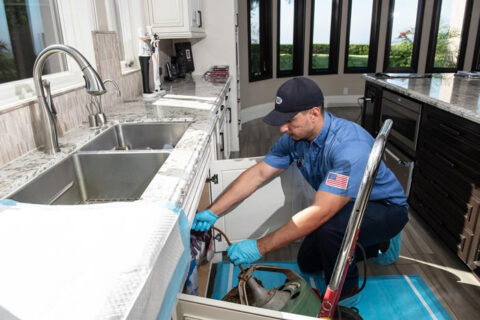How to Transition Your HVAC System From Cooling to Heating
Seasonal AC transition tips can make a huge difference when the weather changes. Switching from heating to cooling or vice versa isn’t just about comfort; it affects your energy bills too, especially during spring hvac maintenance and the transition to your preferred temperature with residential hvac maintenance. Ignoring this shift can lead to higher costs and less efficient cooling or heating.
Knowing how to prepare your AC for seasonal changes is key. Simple actions like cleaning filters, checking refrigerant levels, and scheduling maintenance can enhance performance during the transition. These tips not only ensure your system runs smoothly but also extend its lifespan. Don’t wait until it’s too late; take control of your home’s climate now.
Key Takeaways
-
Understand the seasonal transition by recognizing the need to switch your HVAC system from cooling to heating as temperatures change.
-
Adjust your ceiling fan direction to counterclockwise in winter to help circulate warm air throughout your home.
-
Change your thermostat settings to optimize energy use, ensuring comfort and efficiency during colder months.
-
Schedule regular maintenance for your heating system to prevent breakdowns and ensure it operates efficiently all season long.
-
Replace or check air filters monthly to maintain good airflow and improve indoor air quality.
-
Seal any air leaks in your home to keep the warm air in and reduce energy costs.
Understand Seasonal AC Transition
Importance of Transitioning
Transitioning your HVAC system is crucial. Proper adjustments can greatly enhance seasonal energy efficiency ratio. This ratio measures how effectively your system uses energy during different times of the year. A well-prepared system will run more efficiently, saving you money in the long run.
Energy costs can rise significantly during seasonal shifts. For example, when spring arrives, warmer weather demands cooling. If your air conditioning unit is not ready, it may work harder and consume more energy. This leads to higher bills and unnecessary wear on the equipment.
Timely Adjustments
Making timely adjustments is key. Before temperatures change, inspect your HVAC system. Schedule maintenance checks at least a month before the season shift. This allows technicians to identify issues early. They can clean filters and check refrigerant levels.
Failing to prepare can lead to problems when you need your system most. For instance, if fall comes and you switch to heating mode without checking your furnace, it may fail. Regular maintenance ensures smooth operation.
Energy Bill Savings
Preparing your system for the heating season can yield significant savings on your energy bills. A well-maintained HVAC system operates more efficiently. This means it uses less energy to heat or cool your home.
Homeowners can save up to 20% on their energy bills with proper care. Simple tasks like changing filters or sealing ducts make a big difference. These changes help maintain airflow and reduce strain on the unit.
Seasonal Considerations
Different seasons require different focus areas. In spring, ensure your air conditioning unit is clean and functional. Check for debris around the outdoor unit that can block airflow.
In fall, switch attention to heating systems. Inspect furnaces for dust buildup that can affect performance. Ensure vents are clear and accessible.
Switch HVAC from Cooling to Heating
System Preparation
Switching your HVAC system from cooling to heating requires careful preparation. First, check the thermostat settings. Set it to heating mode instead of cooling mode. This simple change can help initiate the transition smoothly.
Next, inspect the air filters. Dirty filters can restrict airflow and reduce efficiency. Replace or clean them as needed. A clean filter ensures better performance and air quality.
Monitor Performance
After switching modes, monitor the system’s performance closely. Listen for any unusual noises that might indicate a problem. If you hear strange sounds, it may be time to consult experienced HVAC professionals.
Check the temperature in your home regularly. It should reach your set temperature within a reasonable time frame. If not, there could be an issue with the HVAC system. In this case, contacting HVAC services for a professional check-up is advisable.
Energy-Saving Practices
Implement energy-saving practices during the transition to maximize cost-effectiveness. Start by sealing any gaps or leaks around windows and doors. This step helps prevent heat loss. Insulating your home effectively keeps warmth inside during colder months.
Consider using programmable thermostats. These devices allow you to set different temperatures for various times of the day. For example, lower the temperature when no one is home and raise it before returning.
Use ceiling fans wisely. Running them clockwise can help circulate warm air throughout your rooms. This simple adjustment can enhance comfort while reducing heating costs.
Professional Services
Consulting HVAC experts can provide personalized HVAC solutions tailored to your needs. They can assess the system’s efficiency and recommend improvements or repairs if necessary.
Regular maintenance is crucial for modern HVAC systems. Schedule annual check-ups to ensure all components function well. Professionals can clean ducts and check for potential issues before they become major problems.
Seasonal Considerations
Seasonal HVAC preparation is essential for optimal performance year-round. Transitioning from cooling to heating should not be rushed. Take your time to ensure everything is in order.
Being proactive about these changes can lead to improved HVAC efficiency and reduced energy bills over time. Recognizing signs of wear or inefficiency early can save money in the long run.
Adjust Ceiling Fan Direction
Warm Air Circulation
Ceiling fans can play a key role in winter comfort. Rotating ceiling fans clockwise helps enhance warm air circulation. Warm air naturally rises to the ceiling. By reversing the fan direction, it pushes this warm air back down into the room.
This method can make rooms feel warmer without increasing your heating bill. It allows you to maintain a comfortable temperature in your home. Using this simple adjustment can save energy and money during colder months.
Comfortable Temperature
Fans help create a more comfortable environment. They can circulate warm air throughout the space, making it feel cozier. Relying solely on your heating system may not always be necessary.
Using ceiling fans reduces the need for higher thermostat settings. This can lead to lower energy consumption and bills. A well-placed fan can make a significant difference in how warm a room feels.
Experiment with Speeds
Finding the right fan speed is essential for efficiency. Ceiling fans usually have multiple speed settings. Experimenting with these speeds can help identify which works best for winter use.
A slower speed often circulates air effectively without creating a draft. This gentle movement of air feels pleasant and cozy. It also ensures that you’re not wasting energy by running the fan too fast.
Adjusting your ceiling fan direction and speed is an easy way to improve comfort at home. These small changes can lead to big savings on energy costs during the winter months.
Key Benefits of Ceiling Fans in Winter
-
Energy Efficiency: Reduces reliance on heating systems.
-
Cost Savings: Lowers monthly utility bills.
-
Comfort Control: Enhances warmth in living spaces.
Utilizing ceiling fans correctly can transform how you manage indoor temperatures. Many people overlook this simple adjustment, yet it offers valuable benefits.
Change Thermostat Settings
Gradual Adjustments
Gradually adjusting your thermostat settings can help your HVAC system. Sudden changes may stress the system. Start by changing the temperature by a few degrees at a time. This approach allows the system to adapt without overworking itself. For example, if it’s warm outside, set your thermostat a couple of degrees higher than usual.
During colder months, lower the temperature gradually. This practice helps maintain comfort while saving energy. It also prevents unnecessary wear on your heating unit. A good rule of thumb is to change the temperature in increments of 2-3 degrees every few days.

Energy Conservation
Implementing a schedule for your thermostat can save energy and money. Set your thermostat to lower during the night or when you leave home. Most people sleep better in cooler temperatures. A setting around 65 degrees Fahrenheit often feels comfortable at night.
Consider using a programmable thermostat for this purpose. These devices allow you to program temperature schedules easily. You can set specific times for the heater to turn on or off. For instance, program it to heat up before you wake up and cool down when you leave for work.
Programmable Options
Programmable thermostats are beneficial for maintaining optimal temperature settings. They automatically adjust based on your preferences and routines. Many models allow you to set different temperatures for weekdays and weekends.
These thermostats can remember your preferred temperatures. They also help manage temperature fluctuations throughout the day. Some advanced models even connect to Wi-Fi and allow control via smartphone apps.
Investing in a programmable thermostat pays off over time. Studies show that homeowners can save about 10-15% on heating bills with proper use. This savings adds up, especially during peak winter months.
Comfort Levels
Finding your comfortable temperature is essential during seasonal transitions. Everyone has different preferences for warmth and coolness. Monitoring how you feel at various temperatures helps find the right balance.
For many, a comfortable indoor temperature ranges from 68 to 72 degrees Fahrenheit during winter months. Adjusting your thermostat settings within this range ensures comfort without excessive energy use.
Schedule Heating System Maintenance
Annual Tune-Up
Prioritize scheduling an annual heating tune-up. This service helps ensure your system runs reliably and efficiently. A professional inspection can catch small issues before they become major problems. Technicians check for wear and tear, clean components, and replace filters. This proactive approach saves money on future repairs.
Most HVAC systems benefit from a tune-up before winter. Schedule this service in late summer or early fall. Doing so prepares your heating system for the cold months ahead. Check with local HVAC professionals to find the right time for your maintenance.
Research Professionals
Research local HVAC professionals for reputable maintenance services. Look for companies with good reviews and solid reputations. Ask friends or family for recommendations. Online platforms like Yelp and Google Reviews can also provide insights into customer experiences.
Verify that the technicians are licensed and insured. This ensures they meet industry standards. A qualified technician can offer valuable advice on your system’s needs. They can help you understand what maintenance tasks are necessary based on your specific heating system.
Maintenance Log
Keep a maintenance log to track service dates and any repairs needed over time. Record when you schedule HVAC maintenance and what services were performed. This log is useful for tracking patterns in your system’s performance.
A detailed log helps remind you of upcoming maintenance appointments. It also provides important information if you need to troubleshoot issues later. If you ever sell your home, a well-maintained log shows buyers that the system has been cared for.
Regular maintenance increases the lifespan of your heating system. Ignoring it can lead to costly repairs down the line.
Helpful Tips
Follow these helpful spring HVAC maintenance tips:
-
Change air filters regularly.
-
Clear debris from around outdoor units.
-
Check ductwork for leaks.
-
Ensure vents are not blocked.
These simple actions enhance system performance and efficiency.
Replace and Check Air Filters
Monthly Routine
Establish a routine for checking and replacing air filters every month. This simple action helps maintain optimal airflow in your HVAC system. Clogged filters can restrict airflow, leading to higher energy bills and reduced efficiency.
During peak usage months, like summer and winter, monitor the filter condition closely. Dust, pollen, and pet hair can accumulate quickly. A clean air filter will ensure your system runs smoothly.
Filter Types
Educate yourself on the types of filters suitable for your HVAC system. Different systems require different filters. Some may use HEPA filters while others might work better with pleated or fiberglass filters.
Choosing the right filter enhances performance. For example, HEPA filters trap smaller particles effectively. They are ideal for homes with allergies or pets. Understand your system’s specifications to make the best choice.
Regular Monitoring
Monitor the condition of your air filters regularly. Look for signs of dirt or damage. If a filter appears discolored or feels clogged, it’s time to replace it.
Pay attention to how often you run your HVAC system. Increased usage leads to faster buildup of dust and debris. Adjust your replacement schedule based on how frequently you use your system.
Benefits of Clean Filters
Clean air filters provide several benefits. They improve indoor air quality by trapping allergens and pollutants. This is especially important for those suffering from asthma or allergies.
A clean filter reduces strain on the HVAC unit. This can extend the lifespan of the system and lower maintenance costs over time.
Steps to Replace Filters
-
Turn off your HVAC unit before starting.
-
Locate the air filter compartment.
-
Remove the old filter carefully.
-
Inspect the new filter for size and type.
-
Insert the new filter in the correct direction.
-
Close the compartment securely.
-
Turn on the HVAC unit again.
Following these steps ensures that your air filter is replaced correctly.
Ensure Vents Have Good Airflow
Inspect Vents
Inspect all vents and registers in your home. Make sure they are not blocked by furniture or other items. Blockages can reduce efficient cooling and lead to uneven temperatures. For example, a couch placed too close to a vent can restrict airflow. This can cause certain rooms to stay warm while others feel cold.
Regular checks help maintain good airflow. Dust and debris can also accumulate over time. Cleaning these areas improves efficiency. Use a vacuum or a damp cloth to remove dust from the vents.
Test Airflow
Testing airflow is essential for identifying potential blockages. Stand near each register and feel for air movement. If you notice weak airflow, there may be an issue. Check for any visible obstructions in the vent.
You can also use a piece of tissue paper to test airflow. Hold the tissue near the register. If it blows away, the airflow is strong. If it stays still, there might be a blockage. Addressing these issues early helps maintain comfort in your home.
Adjust Vent Positions
Adjusting vent positions directs heat where it is most needed. Some homes have adjustable vents that allow you to change the direction of airflow. Pointing vents toward colder areas can improve heating efficiency.
Consider which rooms need more warmth during colder months. For instance, if a bedroom feels chilly while the living room is warm, adjust the vents accordingly. This simple step ensures better temperature balance throughout your house.
Regular Maintenance
Regular maintenance of your HVAC system supports efficient cooling and heating. Schedule professional inspections at least once a year. Technicians can check ductwork and ensure everything functions properly.
Replace air filters regularly as discussed in the previous section. Clogged filters restrict airflow and reduce system efficiency. A clean filter allows your HVAC system to work effectively.
Monitor Performance
Monitor how well your system performs after making adjustments. Take note of any changes in temperature or airflow throughout your home. If problems persist, consult with an HVAC professional for further evaluation.
Maintaining good airflow through vents is critical for comfort and energy savings. Following these tips will help optimize your home’s heating and cooling performance.
Seal Air Leaks in Your Home
Inspect Gaps
Conduct a thorough inspection of your windows and doors. Look for any gaps or leaks that could let air escape. Even small openings can lead to significant energy loss.
Check the edges of windows and doors closely. If you see light coming through, that’s a sign of a leak. Use your hand to feel for drafts. This simple check can help identify where air is getting in or out.
Replace Weather Stripping
Worn weather stripping can cause drafts. Replacing it is an easy way to improve insulation. Weather stripping comes in various materials, such as foam, vinyl, or rubber.
Choose the right type for your needs. Foam strips are great for irregular surfaces. Vinyl works well for standard door frames. Rubber is durable and often lasts longer.
Install new weather stripping along the edges of doors and windows. Make sure it fits snugly to keep out cold air. This small change can lead to noticeable savings on energy bills.
Use Caulk or Foam Sealant
Consider using caulk or foam sealant for additional sealing around windows and doors. Caulk is ideal for filling small gaps and cracks. It creates a strong barrier against air leaks.
Choose a paintable caulk if you want to match your home’s colors later. Apply caulk with a caulking gun for best results. Smooth it out with your finger or a tool for a clean finish.
Foam sealant is another option for larger gaps. It expands to fill spaces effectively. Be careful when applying it, as it can be messy.
Save Money
Sealing air leaks helps maintain balmy warmth in your home during colder months. This means less reliance on heating systems, which saves money over time.
By improving insulation, you create a more comfortable living environment. The benefits extend beyond just comfort; they impact your wallet too.
Regular maintenance of windows and doors ensures they function properly throughout the year. Taking these steps now will pay off later.
Final Remarks
Transitioning your AC system for the seasons is crucial for comfort and efficiency. You’ve learned key tips to make this switch smooth, from adjusting thermostat settings to sealing air leaks. These steps not only enhance your home’s comfort but also save on energy costs.
Don’t wait until the last minute. Take action now to ensure your HVAC system is ready for the seasonal change. Regular maintenance and simple adjustments can make a significant difference. Stay proactive, and enjoy a cozy home all season long. Your comfort is just a few steps away!
Frequently Asked Questions
What is the best way to transition my AC for the season?
Start by switching your HVAC system from cooling to heating. Adjust thermostat settings and ensure your ceiling fans are set to rotate clockwise for better heat distribution.
How often should I schedule heating system maintenance?
It’s recommended to schedule maintenance at least once a year, ideally before the heating season begins. This ensures efficiency and prolongs the life of your system.
Why is changing air filters important?
Dirty air filters restrict airflow and reduce system efficiency. Regularly changing them improves indoor air quality and helps your HVAC system run smoothly.
How do I adjust my ceiling fan for winter?
In winter, set your ceiling fan to rotate clockwise. This creates an updraft that pushes warm air down, helping maintain a comfortable temperature throughout your home.
What thermostat settings are ideal for winter?
Set your thermostat between 68°F to 72°F during the day. Lower it at night or when away to save on energy costs while keeping your home comfortable.
How can I ensure good airflow from vents?
Make sure vents are unobstructed by furniture or drapes. Regularly check and clean them to prevent dust buildup, ensuring optimal airflow throughout your home.
What should I do about air leaks in my home?
Seal any visible gaps around windows, doors, and ducts using weather stripping or caulk. This prevents drafts and improves energy efficiency, reducing heating costs.


